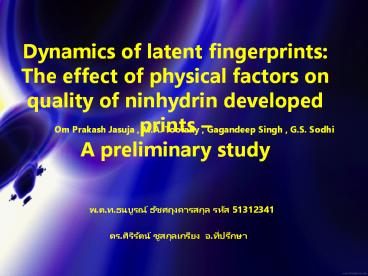Dynamics of latent fingerprints: The effect of physical factors on quality of ninhydrin developed prints - PowerPoint PPT Presentation
Title:
Dynamics of latent fingerprints: The effect of physical factors on quality of ninhydrin developed prints
Description:
Dynamics of latent fingerprints: The effect of physical factors on quality of ninhydrin developed prints A preliminary study Om Prakash Jasuja , M.A. Toofany ... – PowerPoint PPT presentation
Number of Views:113
Avg rating:3.0/5.0
Title: Dynamics of latent fingerprints: The effect of physical factors on quality of ninhydrin developed prints
1
Dynamics of latent fingerprints The effect of
physical factors on quality of ninhydrin
developed prints A preliminary study
Om Prakash Jasuja , M.A. Toofany , Gagandeep
Singh , G.S. Sodhi
?.?.?.??????? ????????????? ???? 51312341
??.????????? ???????????? ?.?????????
2
The objective
The effect of some of exudation of sweat, the
type of surface on which latents are deposited,
the ability of the donor to deposit fingerprints,
contact time, force of contact and their effect
on the ability of ninhydrin (1 ninhydrin
solution) to develop the marks. Latent
fingerprints from good and bad donors were
obtained on paper with variable pressure under
controlled conditions.
3
The previous work
- Thomas 1 studied various physical parameters
of fingerprints such as - their formation, droplet properties, contact
angles, optical properties and - electrical properties.
- Jones et al. 5 discussed a large number of
factors including donor - variations, which may affect the development of
latent fingerprints and - can play a vital role while formulating and
evaluating a fingerprint - development reagent.
4
Overview
- Introduction
- Fingerprint
- ninhydrins
- Experiment
- Results and discussion
- Conclusion
5
Introduction
6
Fingerprints
7
Ninhydrin
Chemiscal Properties
Molecular formula C9H6O4
Molar mass 178.14 g mol-1
Density 0.862 g/cm3
Melting point 250 C, 523 K, 482 F
Formular compound
8
Experimental methods
2.1. Control of pressure 2.2. Control of
exudation of sweat 2.3. prepared ninhydrin 2.4.
The quality of developed fingerprints
9
study as follows
1.consisted of twenty individuals. 2.consisted
of five individuals considered to be good sweat
donors. 3. consisted of five individuals
considered to be bad sweat donors.
10
2.1. Control of pressure
touched finger of the donor on the paper with
placed on a flat pan of a balance.
deposited at pressure equivalent to 50 g, 100 g
150 g and 200 g.
11
2.2. Control of exudation of sweat
covering the donors hand loosely with a polythene
bag for various time periods ranging from 30180
s.
taken off the hands and the index finger was
pressed on the paper as mentioned above.
stored latent fingerprint sample in paper
envelopes.
12
2.3 Ninhydrin was used as the developing reagent
and was prepared as follows
dissolved 1.0 g of Ninhydrin in acetone and
added 2 drops of acetic acid
make volume to 100 mL with acetone
stored in the refrigerator and come to
room temperature half an hour before use.
13
kept ninhydrin solution between 30 and 35 C and
humidity at 5565.
latent fingerprints immersed ninhydrin solution.
dried dry in the open air for a few minutes
before being placed in an oven maintained at 100
C for approximately 2 min.
14
2.4. The quality of developed fingerprints
was graded as follows
Fig. 1. Fingerprint depicting poor quality
(Grade 2).
Fig. 2. Fingerprint depicting medium quality
(Grade 3).
15
Fig. 3. Fingerprint depicting good quality
(Grade 4).
Fig. 4. Fingerprint depicting excellent quality
(Grade 5).
16
Results and discussion
17
Table 1 Effect of Physical Factors on the quality
of latent fingerprints development
Figure no. Induced sweating time (IST) (s) Pressure (g) Quality
1 30 50 Weak
2 30 200 Medium
3 180 50 Good
4 180 200 Excellent
18
Fig. 5. Pressure vs quality at different induced
sweating time (IST) n20 (mixed
population).
19
Fig. 6. Pressure vs quality at different induced
sweating time (IST) in rich donors
n5.
20
Fig. 7. Pressure vs quality at different induced
sweating time (IST) in poor donors
n5.
21
conclusion
a linear effect of force applied to deposit
fingerprints and the sweating characteristics of
a donorcould be established with respect to the
quality of the developed prints, but in case of
good donors smudging of fingerprints took place
when the pressure applied and induced sweating
time exceeded 200 g and 180 s respectively. 120 s
of induced sweating time produced the same
quality of development of the donated
fingerprints irrespective of the donor.
22
Thank you

